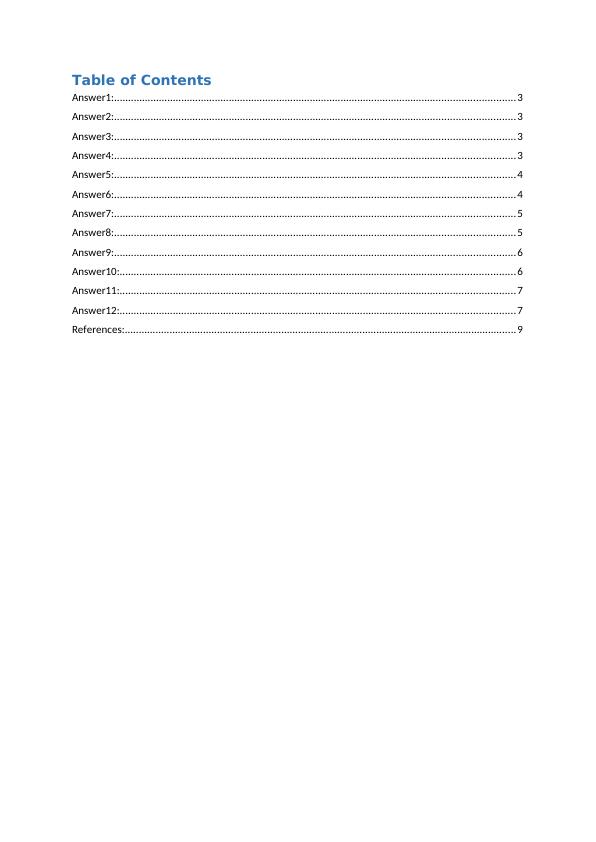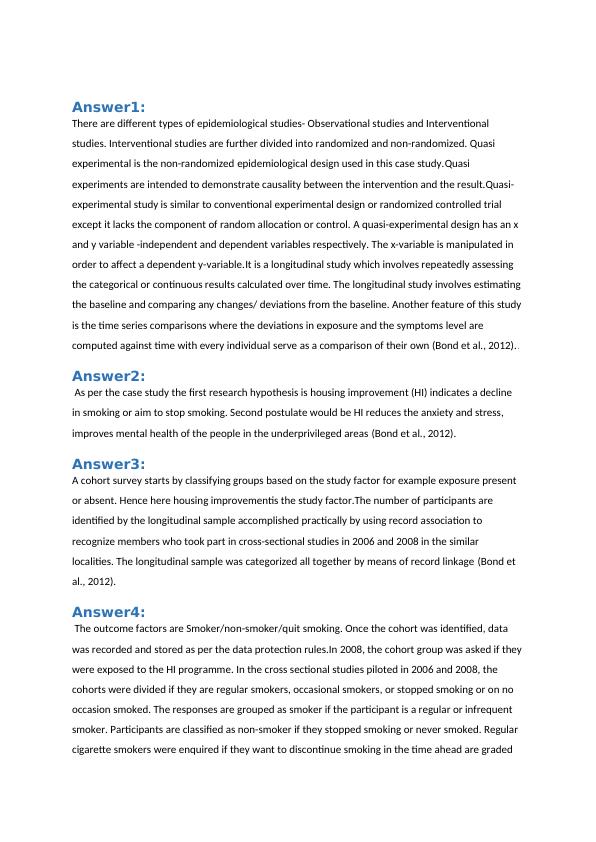Epidemiological Studies and Housing Improvement
Added on 2023-01-23
8 Pages2635 Words98 Views
7312MED EPIDEMIOLOGY: PRINCIPLES AND
PRACTICES
PRACTICES

Table of Contents
Answer1:...............................................................................................................................................3
Answer2:...............................................................................................................................................3
Answer3:...............................................................................................................................................3
Answer4:...............................................................................................................................................3
Answer5:...............................................................................................................................................4
Answer6:...............................................................................................................................................4
Answer7:...............................................................................................................................................5
Answer8:...............................................................................................................................................5
Answer9:...............................................................................................................................................6
Answer10:.............................................................................................................................................6
Answer11:.............................................................................................................................................7
Answer12:.............................................................................................................................................7
References:............................................................................................................................................9
Answer1:...............................................................................................................................................3
Answer2:...............................................................................................................................................3
Answer3:...............................................................................................................................................3
Answer4:...............................................................................................................................................3
Answer5:...............................................................................................................................................4
Answer6:...............................................................................................................................................4
Answer7:...............................................................................................................................................5
Answer8:...............................................................................................................................................5
Answer9:...............................................................................................................................................6
Answer10:.............................................................................................................................................6
Answer11:.............................................................................................................................................7
Answer12:.............................................................................................................................................7
References:............................................................................................................................................9

Answer1:
There are different types of epidemiological studies- Observational studies and Interventional
studies. Interventional studies are further divided into randomized and non-randomized. Quasi
experimental is the non-randomized epidemiological design used in this case study.Quasi
experiments are intended to demonstrate causality between the intervention and the result.Quasi-
experimental study is similar to conventional experimental design or randomized controlled trial
except it lacks the component of random allocation or control. A quasi-experimental design has an x
and y variable -independent and dependent variables respectively. The x-variable is manipulated in
order to affect a dependent y-variable.It is a longitudinal study which involves repeatedly assessing
the categorical or continuous results calculated over time. The longitudinal study involves estimating
the baseline and comparing any changes/ deviations from the baseline. Another feature of this study
is the time series comparisons where the deviations in exposure and the symptoms level are
computed against time with every individual serve as a comparison of their own (Bond et al., 2012)..
Answer2:
As per the case study the first research hypothesis is housing improvement (HI) indicates a decline
in smoking or aim to stop smoking. Second postulate would be HI reduces the anxiety and stress,
improves mental health of the people in the underprivileged areas (Bond et al., 2012).
Answer3:
A cohort survey starts by classifying groups based on the study factor for example exposure present
or absent. Hence here housing improvementis the study factor.The number of participants are
identified by the longitudinal sample accomplished practically by using record association to
recognize members who took part in cross-sectional studies in 2006 and 2008 in the similar
localities. The longitudinal sample was categorized all together by means of record linkage (Bond et
al., 2012).
Answer4:
The outcome factors are Smoker/non-smoker/quit smoking. Once the cohort was identified, data
was recorded and stored as per the data protection rules.In 2008, the cohort group was asked if they
were exposed to the HI programme. In the cross sectional studies piloted in 2006 and 2008, the
cohorts were divided if they are regular smokers, occasional smokers, or stopped smoking or on no
occasion smoked. The responses are grouped as smoker if the participant is a regular or infrequent
smoker. Participants are classified as non-smoker if they stopped smoking or never smoked. Regular
cigarette smokers were enquired if they want to discontinue smoking in the time ahead are graded
There are different types of epidemiological studies- Observational studies and Interventional
studies. Interventional studies are further divided into randomized and non-randomized. Quasi
experimental is the non-randomized epidemiological design used in this case study.Quasi
experiments are intended to demonstrate causality between the intervention and the result.Quasi-
experimental study is similar to conventional experimental design or randomized controlled trial
except it lacks the component of random allocation or control. A quasi-experimental design has an x
and y variable -independent and dependent variables respectively. The x-variable is manipulated in
order to affect a dependent y-variable.It is a longitudinal study which involves repeatedly assessing
the categorical or continuous results calculated over time. The longitudinal study involves estimating
the baseline and comparing any changes/ deviations from the baseline. Another feature of this study
is the time series comparisons where the deviations in exposure and the symptoms level are
computed against time with every individual serve as a comparison of their own (Bond et al., 2012)..
Answer2:
As per the case study the first research hypothesis is housing improvement (HI) indicates a decline
in smoking or aim to stop smoking. Second postulate would be HI reduces the anxiety and stress,
improves mental health of the people in the underprivileged areas (Bond et al., 2012).
Answer3:
A cohort survey starts by classifying groups based on the study factor for example exposure present
or absent. Hence here housing improvementis the study factor.The number of participants are
identified by the longitudinal sample accomplished practically by using record association to
recognize members who took part in cross-sectional studies in 2006 and 2008 in the similar
localities. The longitudinal sample was categorized all together by means of record linkage (Bond et
al., 2012).
Answer4:
The outcome factors are Smoker/non-smoker/quit smoking. Once the cohort was identified, data
was recorded and stored as per the data protection rules.In 2008, the cohort group was asked if they
were exposed to the HI programme. In the cross sectional studies piloted in 2006 and 2008, the
cohorts were divided if they are regular smokers, occasional smokers, or stopped smoking or on no
occasion smoked. The responses are grouped as smoker if the participant is a regular or infrequent
smoker. Participants are classified as non-smoker if they stopped smoking or never smoked. Regular
cigarette smokers were enquired if they want to discontinue smoking in the time ahead are graded

End of preview
Want to access all the pages? Upload your documents or become a member.
Related Documents
Practices and Principles: Epidemiologylg...
|8
|2264
|91
The Question and Answerslg...
|11
|3343
|15
Relationship between Housing Improvement and Desire to Stop Smokinglg...
|10
|3746
|247
Critical Appraisal of a Paperlg...
|13
|3146
|394
